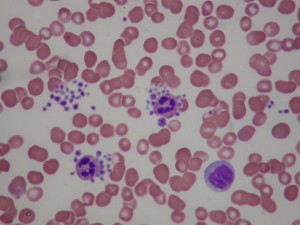QUESTION:
Iron deficiency anemia can cause a high platelet count but can it also cause platelets to clump?
My Lab work said my platelets were clumped on my blood smear but appeared to be increased in number so a manual differential in 8 weeks. This is the second sample in two months to show clumping.
ANSWER:
An increase in platelets is a reaction to the anemia. When the anemia is corrected, the platelet count then returns to its normal range. Complications (thrombosis and thrombo-embolisation)of “reactive thrombocytosis” are extremely rare, and require very high counts (>1 million).
Sometimes Pseudothrombocytopenia (false thrombocytopenia) occurs where the number of platelets, seen on a complete blood count analysis (CBC), may appear low because of the clumping of platelets.
This can lead to a smaller number of platelets seen throughout the slide reviewed by the technician. If this is suspected, the blood can be redrawn in a tube with a material that prevents clumping of platelets for repeat analysis. If thrombocytopenia is seen for the first time, it is prudent to repeat the complete blood count in order to rule out pseudothrombocytopenia (see above). If the repeat CBC confirms low platelet counts, then further evaluation can begin.
The urgency to perform additional testing and evaluation is largely dependent on how low the platelet count is on the blood count and whether there are symptoms: In many instances, thrombocytopenia may have no symptoms, especially if mild, and it can be detected only incidentally on routine blood work done for other reasons.
If thrombocytopenia is severe, for example less than 20 per micro liter, it can potentially manifest as increase bleeding when a person is cut or injured or increased bleeding during menstrual period.
Spontaneous bleeding can also happen with severe thrombocytopenia (less than 10,000 to 20,000 platelets). This type of bleeding usually occurs under the skin or the mucus membrane (the inner lining of the oral cavity, gastrointestinal tract, or the nasal cavity).
Petechiae may be seen in patients with very low platelet counts. Petechiae are small (pin head size) red, flat spots seen under the skin on the dependent parts of the body because of increased pressure due to gravity, for example, on the lower legs. These happen because of bleeding out of the tiny blood vessels under the skin or the mucus membrane. Petechiae are generally not palpable or painful.
Other rashes or bruises seen in thrombocytopenia are called purpura, which are small, purple spots under the skin as a result of hemorrhage. These are typically greater than 3 millimeters in diameter and may represent a confluence of petechiae.
Hope this helps,
Dr T
http://www.cardiac-risk-assessment.com/

